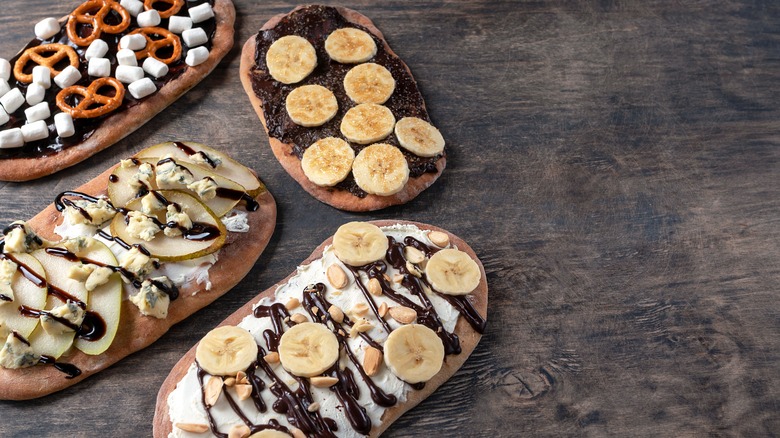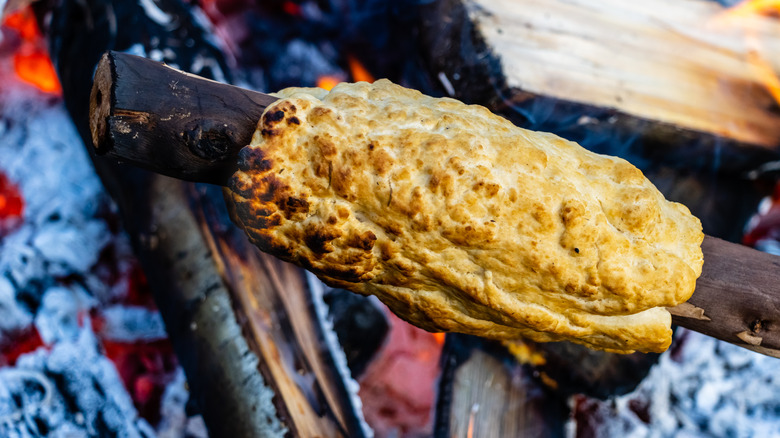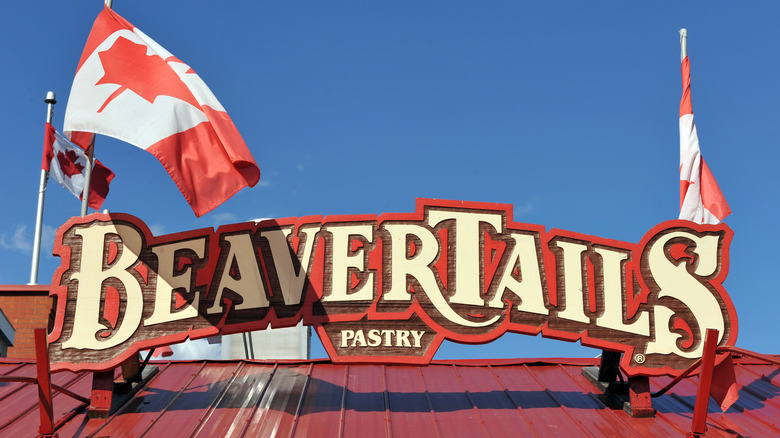What Is A Beaver Tail Pastry? The Classic Flavors You Need To Know
Alongside notable Canadian foods like poutine and Nanaimo bars is another (usually) sweet treat that's perhaps not quite so well known — the beaver tail. Named for its stumpy, plank-like form (unsurprisingly resembling the shape of a beaver's tail), the pastry is part of the doughnut family. Made with ingredients including yeast, eggs, sugar, flour, salt, and vanilla, the dough is pretty similar to that of a yeast doughnut.
But once you form it into its flat shape and fry it, it diverges from your typical doughnut. As a flat pastry, beaver tails are served hot with an array of toppings (and they're seen as a great post-ice skating treat). Cinnamon sugar is a simple classic, or there's the Killaloe Sunrise flavor, a tribute to the hometown of the eponymous BeaverTails chain restaurant, which specializes in this winter-friendly treat. (The flavor consists of cinnamon sugar with some lemon juice added.) You can also go more elaborate with options like an apple-caramel topping or chocolate-hazelnut spread with bananas. There's also the Avalanche, which piles on a cheesecake spread, Skor candy, and caramel. The BeaverTails chain even created a special version when President Barack Obama visited Canada, featuring cinnamon sugar alongside an "O" spelled out in chocolate and maple sauce. Although sweet toppings are the norm, it's also possible to do savory toppings, like garlic and cheese or a "Poutail" (a BeaverTail with poutine on top: Fries, cheese curds, and gravy).
The origins
Beaver tails in their current form have been part of the Canadian food canon for around four decades. The BeaverTails company, which brought the pastry to the mainstream, was founded in 1978 and became popular in the '80s before spreading across Canada and (to a limited extent) the rest of the world. But the dessert's roots go further back — so what is a beaver tail pastry really? And how did it get its start? There are two main theories about its origin. BeaverTails restaurant founders Pam and Grant Hooker, who coined the "beaver tail" name, say that their recipe stems from Grant's German grandmother, who served fried pastry with toppings like honey or jam for breakfast. That pastry is most likely a Bavarian sweet called küchle, although the Hookers made tweaks to the original recipe to speed up their baking process.
But beaver tails also bear a similarity to a type of bread called bannock (pictured above), which is popular among some Indigenous groups in Canada. Like beaver tails, bannock does not need to be left to proof and rise, and while the dough is similar, it was traditionally cooked on a stick over a fire. In this sense, bannock differs in that it's not flat, although it can be served with similar sweet toppings like jam (or on its own, as an accompaniment to dishes like stews). That said, despite the similarity, the BeaverTails company doesn't claim that its pastries have a connection with bannock.
About that name
The name of this Canadian treat is tightly bound up with the company that popularized the dessert: BeaverTails founders Grant and Pam Hooker have said that their daughter came up with it. As a result, the name "beaver tail" is trademarked and belongs to the BeaverTails chain restaurant. But much like words such as "Kleenex" or "Hoover," "beaver tail" is used pretty generally to refer to fried pastries with sweet toppings, regardless of who makes them.
However, the BeaverTails company has been somewhat protective of their name; and officially speaking, chefs, bakeries, and other companies can't use the term without infringing on the trademark. This issue came to a head when a food blogger published a recipe for beaver tails in 2016. The company complained, so she initially changed her recipe name to "beaver doughnuts." When the company also asked that she remove the word "beaver," she renamed her recipe to the tongue-in-cheek "Canadian Semiaquatic Rodent Posterior Doughnuts." The company's legal moves drew social media backlash, and it ultimately apologized to the blogger. The company still wields the trademark for this pastry, although said it wouldn't stake a claim to the word "beaver." As a result, you may see beaver tails referred to as elephant ears (more common in the U.S.) or "Queues de Castor" in French-speaking Canada — but most Canadians still know them as beaver tails.


